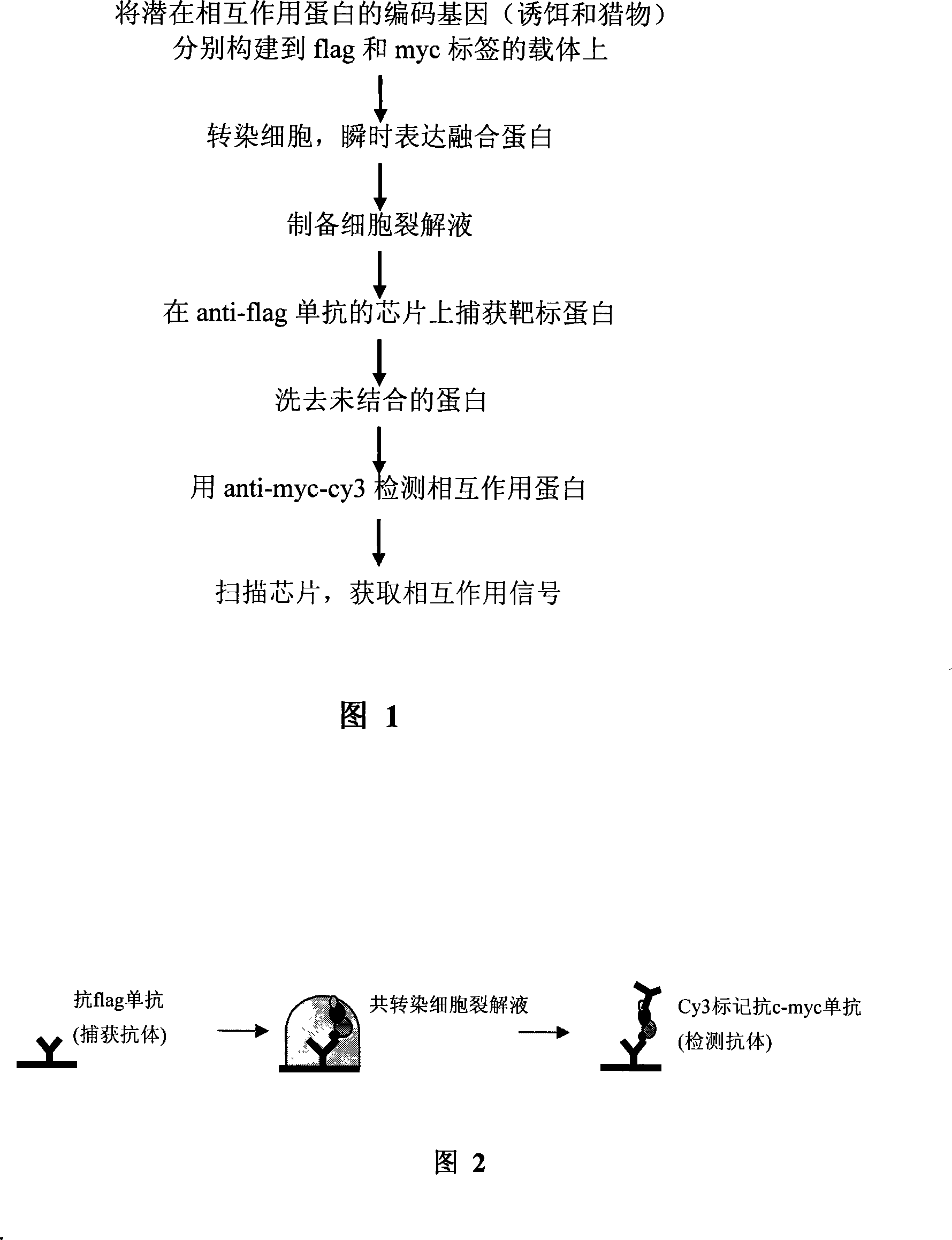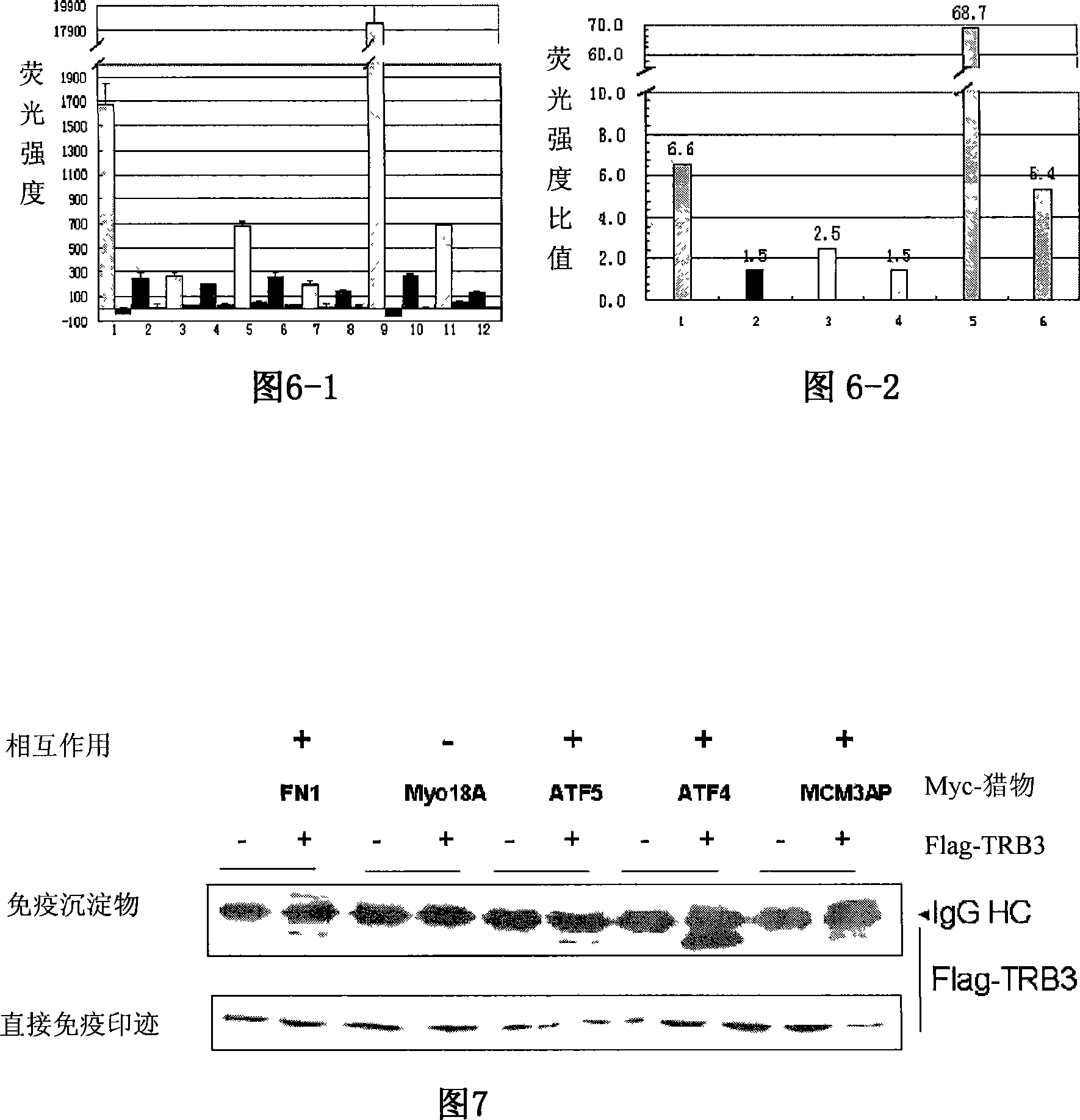Method for detecting protein interaction by immunological coprecipitation based on protein chip and reagent kit for detecting protein interaction
A protein interaction and co-immunoprecipitation technology, applied in the field of protein interaction detection, can solve the problems of complicated operation process, cultivating a large number of cells, limited antibodies, etc. Effect
- Summary
- Abstract
- Description
- Claims
- Application Information
AI Technical Summary
Problems solved by technology
Method used
Image
Examples
preparation example Construction
[0050] Preparation of the Flag antibody chip: Paste a film on the aldehyde-based glass slide to form 3 × 6 chip frames for differentiating samples. Spray the anti-flag M2 monoclonal antibody and mouse IgG (as a control antibody) into each partition frame of the aldehyde-based glass slide, and dot 3 points containing anti-flag M2 monoclonal antibody in parallel in each reaction frame and the corresponding number of Spots containing mouse IgG. Store at 4°C for later use.
[0051] In the embodiment of the present invention, the M2 monoclonal antibody was used. Since the M2 monoclonal antibody is a mouse IgG, mouse IgG was used as the antibody control. The present invention is not limited to the use of M2 monoclonal antibody, and other types of monoclonal antibodies can also be used.
[0052] Construction of bait and prey expression vectors: construct the coding gene of the bait on the flag tag vector, and construct the coding gene of the prey on the Myc tag vector to form flag-...
Embodiment 1
[0055] Example 1: Co-immunoprecipitation chip analysis of the interaction between p65 and p50 subunits of nuclear transcription factor-κB (NF-κB)
[0056] The p65 and p50 subunits of NF-κB exist in the form of heterodimers under physiological conditions, therefore, this example is designed with the interaction between p65 and p50 as positive.
[0057] 1. Preparation of the Flag antibody chip: Paste a film on the aldehyde-based glass slide to form 3×6 chip frames in partitions. Use a microarray spotter (microarrayer, CAPITALBIO Boao, Jingxin SmartArrayer-48) to spray anti-flag M2 monoclonal antibody and mouse IgG (as a control antibody) into each partition frame of the aldehyde-based glass slide, and each reaction Three spots containing anti-flag M2 monoclonal antibody and three spots containing mouse IgG were spotted in the frame. Store at 4°C for later use.
[0058] 2. Construction and identification of bait and prey expression vectors: p65 (NM_021975) and p50 (NM_003998) w...
Embodiment 2
[0105] Example 2: Verification of the interaction of six pairs of potentially interacting proteins by the co-immunoprecipitation chip:
[0106] In this example, six pairs of proteins derived from yeast two-hybrid were verified for interaction by using a co-immunoprecipitation chip.
[0107] In the early stage, TRB3 protein (triblles 3) was used as bait to screen the human liver cDNA library by yeast two-hybrid, and six prey proteins were obtained: FN1, Myo18A, ATF5, ATF4, MCM3AP and HLA-B.
[0108] The bait was constructed on the pFLAG-CMV-2 eukaryotic expression vector (please refer to the method in Example 1), and the six preys were respectively constructed on the pCMV-Myc eukaryotic expression vector (please refer to the method in Example 1).
[0109] Referring to the method in Example 1; Six kinds of pCMV-Myc-prey proteins were co-transfected with pFLAG-TRB3 respectively in HEK-293 cells, and simultaneously six kinds of pCMV-Myc-preys were co-transfected with pFlag-CMV-2 a...
PUM
 Login to View More
Login to View More Abstract
Description
Claims
Application Information
 Login to View More
Login to View More - R&D
- Intellectual Property
- Life Sciences
- Materials
- Tech Scout
- Unparalleled Data Quality
- Higher Quality Content
- 60% Fewer Hallucinations
Browse by: Latest US Patents, China's latest patents, Technical Efficacy Thesaurus, Application Domain, Technology Topic, Popular Technical Reports.
© 2025 PatSnap. All rights reserved.Legal|Privacy policy|Modern Slavery Act Transparency Statement|Sitemap|About US| Contact US: help@patsnap.com



